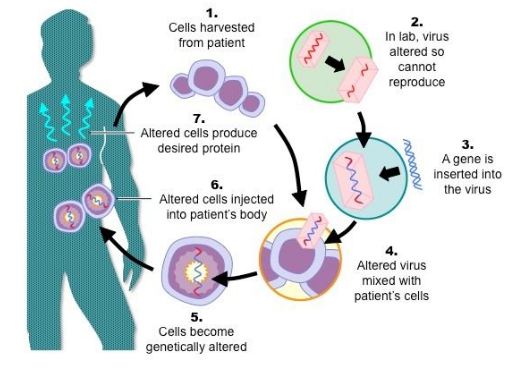Good viruses examples and their role in health

By using biotechnology viruses can be converted into therapeutic agents by reprogramming them to treat diseases. This technique is called virotherapy and it has resulted in the number of good viruses that are being used in virus-based drugs to treat different fatal diseases especially cancer. Virotherapy can also refer more broadly to the use of viruses to treat certain medical conditions by killing pathogens. Bioengineered virus when enter the human systems these cure diseases by Gene overexpression, Gene knockout or gene suicide.
- Gene overexpression adds genetic sequences that compensate for low levels of needed gene expression.
- Gene knockout use RNA method to silence or reduce the expression of disease-causing genes.
- Suicide gene delivery introduces genetic sequences that induce an apoptotic response in cells, usually used to kill cancerous growths.
Good Viruses Examples
Here are some viruses that protect us from diseases and other pathogens.
1- Latent (non-symptomatic) Herpes viruses
Herpes Virus can help human white blood cells to identify cancer cells and cells infected with other pathogenic viruses. They arm WBC cells with antigens (a foreign substance that can cause an immune response in the body) that will allow them to identify tumor cells.
This is a virus survival strategy to remain for a longer time within its host and to get rid of competitive viruses to prevent them from harming the host. In the future, modified versions of viruses like these could potentially be used to attack cancer cells.
2- Pegivirus C or GBV-C
Pegivirus C or GBV-C is a virus that does not cause clinical symptoms. Multiple studies have shown that HIV patients infected with GBV-C live longer compared to patients without it.
The virus slows down the progression of the disease by blocking the host receptors necessary for viral entry into the cell and promotes the release of interferons and cytokines (proteins produced by white blood cells that activate inflammation and remove infected cells or pathogens).
3- Noroviruses
Noroviruses were shown to protect the gut of mice when given antibiotics. The protective gut bacteria that were killed by the antibiotics made the mice susceptible to several gut infections. But in the absence of good bacteria, these noroviruses were able to protect their hosts.
4- Newcastle disease virus (NDV)
NDV is an avian paramyxovirus in the family Paramyxoviridae. This virus infects different avian species worldwide, causing a disease called as Newcastle disease. In the 1950’s it was found that NDV has cytotoxic effects on Ehrlich ascites tumor cells. In 1964, Wheelock and Dingle reported that repeated injection of NDV to a patient with acute leukemia treated the disease.
So, naturally occurring NDV strains were investigated as a virotherapy agent for various human cancers. In humans, NDV poses no hazard to human health and causes transient conjunctivitis and mild flu-like symptoms only. So far, several mesogenic and lentogenic strains of NDV have been successfully used as oncolytic virotherapy in mouse tumor models and cancer patients.
5- Measles viruses
The Edmonston vaccine strain of measles virus and CD8+ NKG2D+ cells induce apoptosis via the extrinsic pathway in the hepatocellular carcinoma cells. Thus strains of measles have successfully induced suicidal effects in tumor cells resulting in the treatment of cancer. Measles strains work by increasing the apoptotic ability of CD8+ NKG2D+ cells when infected cancer cells. Other viruses of Paramyxoviridae family also possess this character and their oncolytic property has been studied vividly.
6- Bacteriophages
“Bacteriophages or phages are viruses that infect and destroy germs. These are found in humans in the lining of the mucous membrane of the digestive, respiratory and reproductive systems”
Mucus or mucosa is a thick, amorphous material that provides an anti-bacterial barrier and protects cells below it from infection.
Recent research indicates that the Phages living in the in mucus are part of our natural immune system, as they protect the human body from invading the most dangerous germs.
Phages have already been used to treat diarrhea and food poisoning caused by Staphylococcus aureus, Salmonella and skin infections for nearly a century. Earlier, the primary sources of germs were water, dirt, air, sewage and even body fluids from the infected patients. Viruses were isolated from these sources, purified, and then used for treatment.
Phages have attracted renewed interest as drug-resistant infections are becoming more and more day by day. Recently, it was reported that a teenager in the United Kingdom was on the verge of dying and Bacteriophages were successfully used to treat her serious bacterial infections.


Today, phages are genetically modified. The individual phage strains are tested against target bacteria, and the most effective strains are purified in a potent concentration.
These are stored as bacteriophage stocks (cocktails), which contain one or more phage strains and can target a wide range of bacteria, or as adapted bacteriophages, which target specific bacteria.
Before treatment, a swab is collected from the patient’s infected area, cultured in the laboratory to identify the bacterial strain, and analyzed for therapeutic phage stocks available.
The treatment can be safely administered orally, applied directly to bacterial wounds or lesions, or even spread on infected surfaces. Clinical trials for intravenous phage administration are ongoing.
Related posts:
- Definition, structure and functions of viruses
- General characteristics of viruses
- Classification of viruses
- Replication in viruses
- Benefits of viruses
